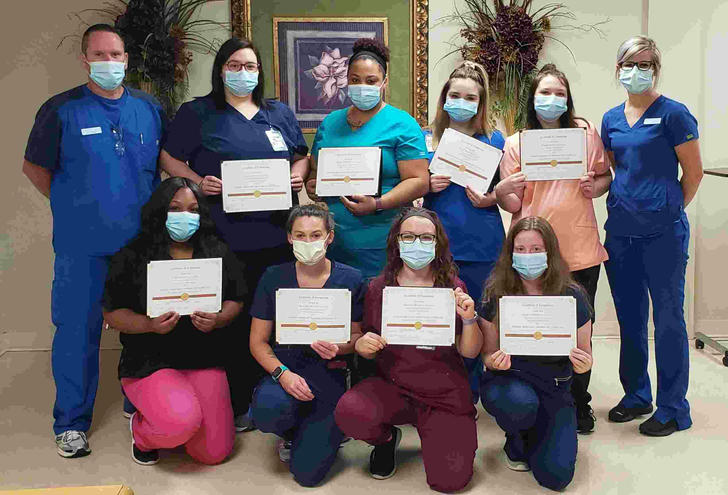LPN Apprenticeship Program-Start High-Paying Career
According to the U.S. Bureau of Labor Statistics (BLS) 2023 data, the demand for licensed practical nurses (LPNs) will grow by 9% between 2022 and 2032 (compared to the industry average of 5%), with approximately 63,800 new positions. For those who want to quickly enter the healthcare industry and earn money while learning, LPN apprenticeship programs are a perfect option.
This article explores the demand for LPNs, job outlook, salary expectations, organizations that offer LPN apprenticeship programs, and how to apply.

What is LPN Apprenticeship Program?
The LPN Apprenticeship Program is a "learning while working" vocational training model designed by medical institutions, community colleges, and the government to help trainees obtain professional qualifications in a short period of time.
Core model: Trainees work for a salary (usually 20-30 hours per week) in partner hospitals or nursing institutions, complete theoretical courses, pass the NCLEX-PN exam, and finally obtain an LPN license.
Difference from traditional education: The traditional path requires attending 1-2 years of nursing school at one’s own expense, while the apprenticeship program reduces the financial burden through wages and subsidies.
LPN employment prospects and salary benefits
1. Salary level: According to BLS data, the average hourly wage of LPNs in 2023 is $38, and the median annual salary is $63,090. In some areas, the hourly wage exceeds $50.
2. Benefits: Employers provide medical insurance and tuition subsidies (such as Kaiser Permanente provides employees with a $5,000 continuing education fund per year).
3. Career advancement: LPNs can be promoted to registered nurses (RN) with additional training.
Advantages of the LPN Apprenticeship Program
1. Earn while learning, low economic cost
Government subsidies, corporate funding, paid work covers living costs, and some programs also waive most of the tuition fees.
For example, Pennsylvania's "Medical Talent Program" provides apprentices with a $400 subsidy per week and reimburses NCLEX-PN exam fees.
2. Flexible learning
Theoretical courses mostly adopt a hybrid teaching mode (online + offline), balancing work and study.
3. Rich practical experience
Apprentices directly participate in clinical care, reducing the job adaptation period.
4. Employment guarantee
Partner hospitals give priority to hiring apprentice graduates. For example, 80% of the LPNs recruited by Cleveland Clinic in 2023 came from its internal apprenticeship program.
Institutions that offer LPN apprenticeship programs
Many institutions or companies provide paid LPN training. Here are some of the main institutions.
1. Government-led programs
Federal level:
The Department of Labor's "Registered Apprenticeship Program" provides trainees with up to $8,000 in tuition subsidies each year and provides employers with $5,000 per person tax credits.
Case: Ohio will train 1,200 LPN through this program in 2023, and federal funds will cover 80% of tuition.
State-level programs:
Texas "Lone Star Nursing Program": The state government covers 90% of tuition fees, partner hospitals provide paid jobs with an hourly wage of $35, and rural workers can receive a $10,000 settlement subsidy.
Pennsylvania's "Medical Talent Bridge Program": Trainees receive a monthly living allowance of $500, and the employment rate is as high as 95%.
2. Corporate cooperation projects
Kaiser Permanente "Future Nurse Program": Covering 8 states, trainees enjoy tuition reimbursement and an $500.
Ascension Health "Pathway to Nursing": No additional cost, starting salary of $38/hour for graduates, $4,000 signing bonus.
HCA Healthcare "Career Ladder Program": Tiered funding (50%-75% tuition reimbursement), encouraging LPN to promote RN and providing $7,500 per year degree subsidy.
3. Community colleges and local support
Miami Dade College: Tuition for Florida residents is only $3,200 (original price $8,500), and partner hospitals have reserved 200 paid positions.
Dallas Community College: High school graduates can obtain both high school credits and nursing course credits, saving 6 months of training time. Local companies such as Texas Instruments (TI) sponsor 50 trainees per year at $5,000 per person.
4. Support from non-profit organizations and industry alliances
National Nursing Alliance: Provides "last dollar" scholarships for low-income families to fill miscellaneous expenses not covered by government subsidies (such as uniforms, stethoscopes, etc.).
American Legion: Veterans and their spouses who apply for the LPN apprenticeship program can receive an additional $2,000/year housing subsidy.
Content and application of LPN apprenticeship program
1. Training structure:
Theoretical learning: online or offline courses, basic nursing, pharmacy principles, first aid techniques and other courses.
Clinical practice: rotation in cooperative institutions or hospitals, covering geriatric care, pediatrics, postoperative care and other departments.
2. Application Process
Qualification review: High school or GED education, pass a background check.
Application materials submitted: Transcripts, letters of recommendation, personal statement.
Selection process: Most institutions require a written test and interview.
Registration exam: After completing training, submit an application for the NCLEX-PN exam through the state nursing board.
Conclusion
LPN has become a popular choice for vocational education in the United States with its low threshold, high demand and flexible promotion. The apprenticeship program further reduces the entry cost and seamlessly connects training and employment.
For people who seek a stable career and want to enter the medical field quickly, the LPN apprenticeship program is an ideal path that combines economy and practicality.
